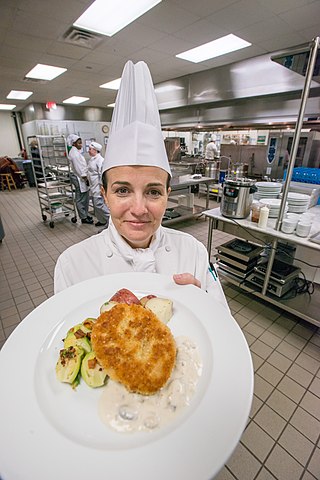
A cuisine is a style of cooking characterized by distinctive ingredients, techniques and dishes, and usually associated with a specific culture or geographic region. Regional food preparation techniques, customs, and ingredients combine to enable dishes unique to a region.

Diana Kennedy MBE was a British food writer. The preeminent English-language authority on Mexican cuisine, Kennedy was known for her nine books on the subject, including The Cuisines of Mexico, which changed how Americans view Mexican cuisine. Her cookbooks are based on her fifty years of travelling in Mexico, interviewing and learning from several types of cooks from virtually every region of the nation.

Gastronomy is the study of the relationship between food and culture, the art of preparing and serving rich or delicate and appetizing food, the cooking styles of particular regions, and the science of good eating. One who is well versed in gastronomy is called a gastronome, while a gastronomist is one who unites theory and practice in the study of gastronomy. Practical gastronomy is associated with the practice and study of the preparation, production, and service of the various foods and beverages, from countries around the world. Theoretical gastronomy supports practical gastronomy. It is related with a system and process approach, focused on recipes, techniques and cookery books. Food gastronomy is connected with food and beverages and their genesis. Technical gastronomy underpins practical gastronomy, introducing a rigorous approach to evaluation of gastronomic topics.
Gourmet is a cultural idea associated with the culinary arts of fine food and drink, or haute cuisine, which is characterized by refined, even elaborate preparations and presentations of aesthetically balanced meals of several contrasting, often quite rich courses. Historically the ingredients used in the meal tended to be rare for the region, which could also be impacted by the local state and religious customs. The term and the related characteristics are typically used to describe people with refined tastes and enthusiasm. Gourmet food is frequently provided in more expensive, smaller servings. When it comes to Gourmet, there are also frequently cross-cultural interactions that introduce new ingredients, materials, and traditions.

Hong Kong cuisine is mainly influenced by Cantonese cuisine, European cuisines and non-Cantonese Chinese cuisines, as well as Japanese, Korean and Southeast Asian cuisines, due to Hong Kong's past as a British colony and a long history of being an international port of commerce. Complex combinations and international gourmet expertise have given Hong Kong the labels of "Gourmet Paradise" and "World's Fair of Food".

Culinary arts are the cuisine arts of food preparation, cooking, and presentation of food, usually in the form of meals. People working in this field – especially in establishments such as restaurants – are commonly called chefs or cooks, although, at its most general, the terms culinary artist and culinarian are also used. Table manners are sometimes referred to as a culinary art.

Molecular gastronomy is the scientific approach of cuisine from primarily the perspective of chemistry. The composition, properties and transformations of an ingredient are addressed and utilized in the preparation and appreciation of the ingested products. It is a branch of food science that approaches the preparation and enjoyment of nutrition from the perspective of a scientist at the scale of atoms, molecules, and mixtures.

Marcel Rouff was a prolific novelist, playwright, poet, journalist, historian, and gastronomic writer. With Curnonsky he wrote the multi-volume work La France gastronomique, guide des merveilles culinaires et des bonnes auberges françaises. He may be best known today for his novel about the fictional gourmet Dodin-Bouffant, La vie et la passion de Dodin-Bouffant, Gourmet, which was first published in 1924 and dedicated to his friend Curnonsky and the great nineteenth-century French gastronome Jean-Anthelme Brillat-Savarin. Rouff's novel was adapted for French television in 1973 by Jean Ferniot.
Food heritage is a term that encompasses the origins of plants and animals and their dispersal, the sites where people first cultivated plants and domesticated animals, as well as the earliest locations around the world where people first processed, prepared, sold and ate foods. These locations include farms, all types of mill, dairies, orchards, vineyards, breweries, restaurants and cafes, markets and groceries, hotels and inns. Food museums help to preserve global and local food heritage. Agropolis Museum in Montpellier, France is an example of a Food museum.

Fuchsia Dunlop is an English writer and cook who specialises in Chinese cuisine, especially Sichuan cuisine. She is the author of seven books, including the autobiographical Shark's Fin and Sichuan Pepper (2008). According to Julia Moskin in The New York Times, Dunlop "has done more to explain real Chinese cooking to non-Chinese cooks than anyone".

A foodie is a person who has an ardent or refined interest in food, and who eats food not only out of hunger but also as a hobby. The related terms "gastronome" and "gourmet" define roughly the same thing, i.e. a person who enjoys food for pleasure; the connotation of "foodie" differs slightly—a sort of everyman with a love for food culture and different foods. Some, such as Paul Levy, say the foodie can still be a "foodist".
Pamela Sheldon Johns is the author of seventeen cookbooks specializing in Italian traditional and regional ingredients. Her career, for more than twenty years, has included teaching, food photography/food styling, cooking school administration, food writing, innkeeping, and agriculture. She lives at Poggio Etrusco, www.Poggio-Etrusco.com, her organic farm and Bed & Breakfast in southern Tuscany, and produces an extra-virgin olive oil called "Pace da Poggio Etrusco."
A global cuisine is a cuisine that is practiced around the world. A cuisine is a characteristic style of cooking practices and traditions, often associated with a specific region, country or culture. To become a global cuisine, a local, regional or national cuisine must spread around the world, its food served worldwide. There have been significant improvements and advances during the last century in food preservation, storage, shipping and production, and today many countries, cities and regions have access to their traditional cuisines and many other global cuisines.

Janna Gur is an Israeli food writer, editor, translator and cook book author and an expert on Israeli and Jewish cuisine. She was the chief editor and the publisher along with her husband Ilan Gur of "Al Hashulchan" culinary magazine for 27 years.

Oaxacan cuisine is a regional cuisine of Mexico, centered on the city of Oaxaca, the capital of the eponymous state located in southern Mexico. Oaxaca is one of Mexico's major gastronomic, historical, and gastro-historical centers whose cuisine is known internationally. Like the rest of Mexican cuisine, Oaxacan food is based on staples such as corn, beans and chile peppers, but there is a great variety of other ingredients and food preparations due to the influence of the state's varied geography and indigenous cultures. Corn and many beans were first cultivated in Oaxaca. Well known features of the cuisine include ingredients such as chocolate, Oaxaca cheese, mezcal and grasshoppers (chapulines) with dishes such as tlayudas, Oaxacan style tamales and seven notable varieties of mole sauce. The cuisine has been praised and promoted by food experts such as Diana Kennedy and Rick Bayless and is part of the state's appeal for tourists.

Joseph Favre was a famously skilled Swiss chef who worked in Switzerland, France, Germany, and England. Although he initially only received primary education because of his humble origins, as an adult he audited science and nutrition classes at the University of Geneva, and would eventually publish his four-volume Dictionnaire universel de cuisine pratique, an encyclopedia of culinary science, in 1895.
Traveling Spoon is a San Francisco, California-based food tourism startup company that connects travelers with local hosts who prepare homemade local cuisine in their homes. Travelers can also purchase cooking classes and visit marketplaces for cooking ingredients with their hosts. The company offers home dining packages in 38 cities in 15 countries located throughout South and Southeast Asia and Japan.
Monégasque cuisine is the cuisine of the principality of Monaco. It is a Mediterranean cuisine shaped by the cooking style of Provence and the influences of nearby northern Italian and southern French cooking, in addition to Monaco’s own culinary traditions. There is an emphasis on fresh ingredients, with the use of seafood, vegetables and olive oil playing a major role in the cuisine.

Cuisine of Berlin describes different aspects of Berlin's culinary offerings. On the one hand, it means the traditional Berlin cuisine of Berlin households with dishes from the German cuisine. On the other hand, often a rustic pub and snack kitchen, which has become increasingly international due to many migration waves since 1945 and 1990. After 2000, numerous top-class restaurants have evolved in Berlin.

Slow tourism is an alternative tourism choice in contrast to mass tourism. Slow tourism is a part of the sustainable tourism family, different from mainstream tourism and emphasizing the tourist’s greater personal awareness. It is characterized by reducing mobility and by taking time to explore local history and culture, while supporting the environment. The concept emerged from the Italian Slow Food movement and the Cittaslow movement.

















